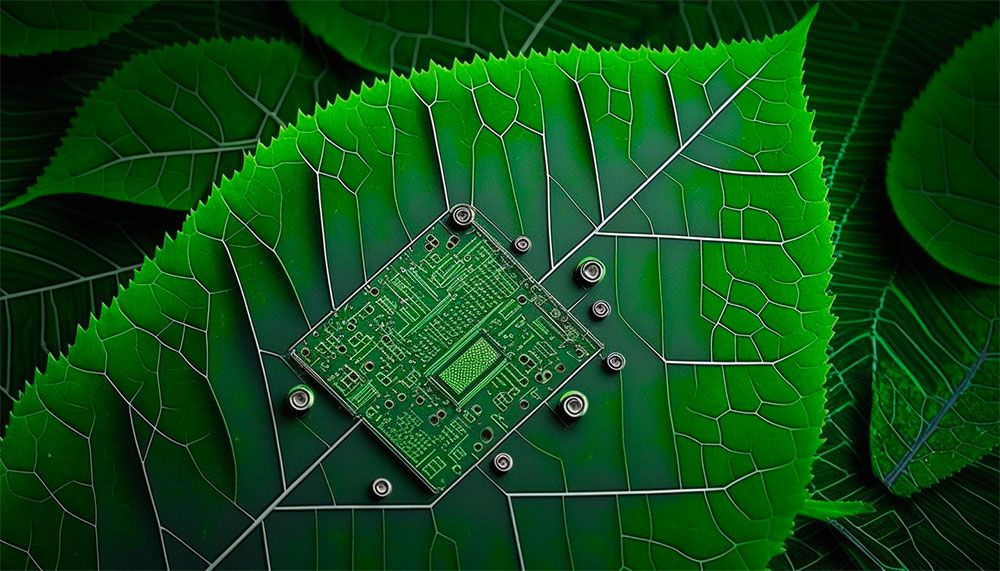Building Sustainable AI Solutions: How Generative AI Development Companies Are Contributing to Green Tech
Discover how generative AI development companies are paving the way for sustainable technology solutions, contributing to a greener future through innovative practices.

The growing concerns around climate change and environmental degradation have spurred the development of green technology, which aims to reduce the negative environmental impact of various industries. Among the emerging solutions to address these challenges is Generative AI, a powerful tool that can drive efficiency, sustainability, and eco-friendly practices across industries. By harnessing the potential of Generative AI development services, businesses can contribute to a greener future while improving their own operational performance.
In this blog, we will explore how Generative AI development companies are leveraging sustainable AI solutions to promote green tech and contribute to environmental sustainability. From reducing energy consumption to optimizing resource use, AI for energy efficiency, and eco-friendly AI solutions, the role of AI in renewable energy and sustainability is becoming more significant than ever.
The Role of Generative AI in Green Technology
1. AI for Energy Efficiency
One of the most immediate applications of Generative AI in green technology is its ability to enhance energy efficiency. The challenge of reducing energy consumption while maintaining productivity is faced by industries worldwide, from manufacturing to transportation. By applying AI for energy efficiency, businesses can optimize their energy use, reduce waste, and improve operational performance.
For instance, Generative AI can be used to optimize heating, ventilation, and air conditioning (HVAC) systems in large buildings or factories. Through machine learning for environmental sustainability, AI can analyze patterns in temperature, air quality, and energy consumption to adjust settings dynamically, reducing unnecessary energy use.
Moreover, AI-driven solutions can be applied to smart grids, where they monitor electricity consumption and balance energy loads to optimize the distribution of renewable energy sources like wind and solar power. This improves grid efficiency, reduces reliance on fossil fuels, and contributes to a more sustainable energy system.
2. Optimizing Renewable Energy Production
Generative AI is playing a critical role in the optimization of renewable energy production, particularly in the management of solar and wind energy. These renewable sources are intermittent by nature, meaning their energy output varies based on weather conditions, time of day, and seasonal fluctuations. AI models can predict energy production levels based on real-time weather data and historical patterns, ensuring that energy production is maximized and integrated into the power grid efficiently.
In the case of wind turbines, Generative AI development services can predict when wind conditions are most favorable for optimal energy generation, allowing operators to adjust the turbine settings accordingly. Similarly, solar panel arrays can be adjusted in real-time based on weather forecasts and environmental factors to maximize energy absorption.
3. Reducing Carbon Footprints in Manufacturing
The manufacturing sector is one of the largest contributors to global carbon emissions, primarily due to energy-intensive processes. AI-powered enterprise solutions can help companies reduce their carbon footprints by optimizing production processes, improving energy management, and reducing waste. By integrating sustainable AI innovations, businesses can achieve significant environmental impact reductions without sacrificing productivity or profitability.
For example, Generative AI can optimize supply chains by predicting the most energy-efficient routes for raw materials and finished products, minimizing transportation emissions. AI can also optimize manufacturing processes by identifying inefficiencies, reducing energy consumption, and even predicting maintenance needs to prevent costly energy losses due to equipment malfunctions.
4. Green AI Initiatives in Agriculture
The agriculture industry, while essential for feeding the world’s population, is also a major contributor to environmental degradation through water consumption, land use, and fertilizer runoff. Software Development Services are applying AI to improve agricultural sustainability by optimizing farming practices. AI models can analyze soil health, weather data, and crop conditions to recommend precise irrigation schedules and fertilizer application, which minimizes water use and reduces chemical runoff.
Additionally, AI-driven software can help farmers monitor crop health in real-time, predict pest infestations, and optimize harvest schedules to reduce waste and maximize yield. These applications reduce the environmental footprint of farming while promoting food security and sustainable practices.
5. AI for Waste Reduction and Circular Economy
The concept of a circular economy involves reducing waste and reusing materials to create a more sustainable business model. Generative AI can play a key role in facilitating waste reduction by optimizing recycling processes, minimizing packaging waste, and ensuring that materials are used efficiently throughout their lifecycle.
For example, AI models can predict the demand for recycled materials based on trends in consumer behavior and manufacturing needs, allowing companies to better manage the supply of recycled goods. Additionally, AI can optimize waste sorting systems, improving the efficiency and accuracy of material recovery in recycling plants, thus contributing to a more sustainable waste management process.
Benefits of Investing in Generative AI for Green Tech
1. Improved Efficiency
Generative AI can significantly improve operational efficiency by automating complex processes, optimizing energy usage, and reducing waste. This leads to reduced costs and better resource management, making businesses more profitable and sustainable at the same time. For instance, AI can analyze vast amounts of data from renewable energy sources and make real-time adjustments to maximize efficiency.
2. Cost Savings
While the initial investment in Generative AI development services can be substantial, the long-term cost savings are significant. By improving energy efficiency, reducing waste, and optimizing resource management, businesses can lower operating costs and achieve higher profit margins. Additionally, AI-driven solutions can minimize costly equipment failures by predicting maintenance needs, further reducing costs.
3. Enhanced Personalization for Sustainable Solutions
Generative AI enables businesses to provide personalized solutions that cater to specific environmental challenges. For example, AI can help manufacturers identify customized sustainability practices based on the specific needs of their industry or operations. Similarly, AI-powered tools can provide customers with personalized recommendations for eco-friendly products or services, helping drive more sustainable purchasing behavior.
4. Contribution to a Greener Future
By implementing eco-friendly AI solutions, businesses are not only improving their efficiency and profitability but also contributing to the global effort to combat climate change. Generative AI is playing a pivotal role in addressing some of the most pressing environmental challenges of our time, from optimizing renewable energy production to reducing waste and carbon emissions.
How to Get Started with Generative AI for Green Tech
1. Assess Your Business Needs
Before implementing Generative AI solutions, it’s essential for businesses to assess their sustainability goals and identify the areas where AI can have the greatest impact. Whether you’re looking to optimize energy use, reduce carbon emissions, or improve waste management, defining clear objectives will help ensure the success of AI initiatives.
2. Partner with a Reliable Generative AI Development Company
To ensure a smooth deployment of AI-driven market trends and sustainable AI innovations, businesses should partner with a reputable Generative AI development company. A trusted AI development company will have the expertise to design and implement customized solutions that align with your sustainability goals, ensuring that AI is deployed effectively and responsibly.
3. Implement AI Solutions Across Operations
Once you’ve partnered with the right AI provider, the next step is to integrate AI solutions into your existing business operations. This could involve deploying AI models to optimize energy consumption, enhance supply chain management, or improve waste reduction. Be sure to monitor the performance of these AI systems and gather feedback to continuously improve their effectiveness.
4. Track and Measure Results
To assess the success of your AI-powered enterprise solutions, it’s important to track and measure the impact of AI on sustainability. This could involve monitoring reductions in energy consumption, tracking carbon footprint reductions, or measuring improvements in resource efficiency. Regularly reviewing these metrics will help ensure that AI continues to deliver value and drive sustainable outcomes.
User Experience with Generative AI for Green Tech
A leading renewable energy provider implemented Generative AI to optimize their wind turbine performance and energy distribution. By using AI-driven solutions, they achieved a 20% increase in energy efficiency and reduced maintenance costs by 15%—a significant step toward a more sustainable and cost-effective operation.
Conclusion: The Future of Green Tech with Generative AI
The role of Generative AI development and AI chatbot development services in driving green technology and sustainability is immense. From optimizing energy efficiency and reducing carbon emissions to revolutionizing the way industries manage resources, AI for environmental sustainability offers businesses an opportunity to contribute to a greener future while improving their bottom line. By embracing sustainable AI solutions, companies can improve their efficiency, reduce operational costs, and enhance their environmental impact, all while staying competitive in an increasingly eco-conscious market.
As businesses look to the future, partnering with a reliable Generative AI development company is crucial to realizing the full potential of AI-powered environmental solutions. Explore AI solutions for sustainability today and take the first step toward a greener, more efficient future.
Frequently Asked Questions (FAQs)
Q: How can a generative AI development company contribute to sustainable technology?
Generative AI development companies can contribute by developing AI solutions that optimize energy use, reduce waste, and improve efficiency in various industries, such as manufacturing, energy, and agriculture.
Q: What role does generative AI play in promoting eco-friendly business practices?
Generative AI helps businesses reduce their environmental impact by optimizing operations, enhancing energy efficiency, and supporting waste reduction initiatives, all while improving productivity and profitability.
Q: How are generative AI solutions used to reduce energy consumption and carbon footprints?
Generative AI solutions help reduce energy consumption by optimizing processes, such as energy usage in buildings, production lines, and smart grids. They also contribute to lowering carbon footprints by improving energy efficiency and enabling more effective use of renewable resources.
What's Your Reaction?

















